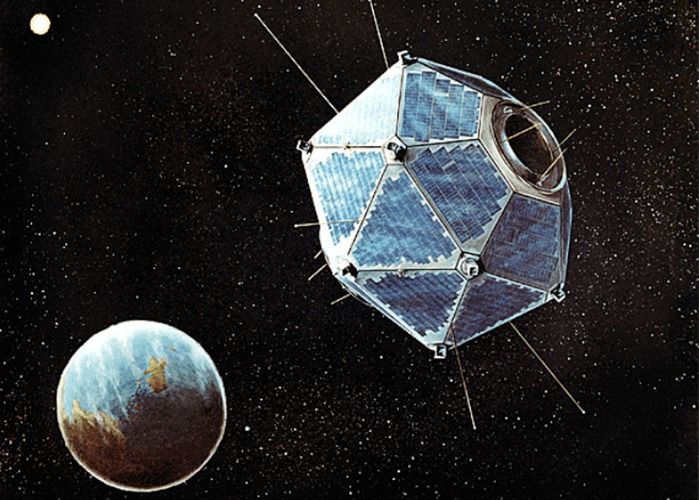Space Force: Lost in space?
By Lawrence J. Korb | August 24, 2018
 Artist's conception of satellite and Earth. Courtesy of Lawrence Weiss
Artist's conception of satellite and Earth. Courtesy of Lawrence Weiss
President Trump’s directive to the Defense Department to do more to deal with military threats in space should not come as a surprise. For those of us who missed it among the usual rush of news emanating from the White House, this directive—whose plans were unveiled by Vice President Mike Pence on August 9 during a speech at the Pentagon—concerns the creation of a $8 billion proposed “Space Force” which would be a entirely new branch of the military. It is not clear what, exactly, the new force would do, nor even where he would get the authority to establish it; as Jonathan Turley, a professor at Georgetown University’s law school, told Defense News: “Congress alone has the power to establish a new branch of the military and to establish the positions of senior executive officials to lead such a department.”
To be sure, the idea has been around for a while. Even though President Trump garnered a lot of attention with his call for a separate space force, this issue has been on the table since at least the beginning of this century. In 2000, Donald Rumsfeld chaired a congressionally mandated commission that recommended consolidating the space-related activities of the Defense Department under the Undersecretary of the Air Force. (The reforms were not implemented by Rumsfeld when he became Secretary of Defense because of the 9/11 attacks.) Since 2007, when the Chinese shot down one of their satellites, there has been more emphasis on making our space forces more resilient. And the House Armed Services Committee included language in the fiscal year 2018 National Defense Authorization Act that would have created a Space Corps as part of the Air Force, much like the Marines are part of the Navy. This provision was dropped from the bill because of opposition from the Trump administration.
But let us assume that the president can get the approval and the funding. What are the merits of the proposal? We need to examine whether it is desirable (or even feasible), and think about what would be involved in starting a new branch of the armed services from scratch; how we would we avoid duplication of effort; and whether we really need it.
There is no doubt that the United States needs to insure that it has unfettered access and freedom to operate in space; to do so, it needs to protect our thousands of satellites from potential attacks by our strategic competitors, especially Russia and China. And that our space-related functions are addressed in a more centralized manner.
The problem with the president’s directive lies in how he wants to do it. Trump argues that the challenges cannot be met effectively without the creation of an entirely separate Space Force. Which is where it is instructive to look at the history of previous new military programs.
Since the creation of the US Defense Department in 1947, the missions and the threats that our military must meet have constantly evolved. Each time a new capability was deemed necessary to protect our security, our civilian and military leaders eventually made the proper organizational and financial changes necessary to deal with these new challenges. But these changes did not come without some resistance from those who were profiting from the status quo or wanted more dramatic changes.
For example, Admiral Rickover, the father of the “Nuclear Navy,” initially resisted the idea of developing a submarine-launched ballistic missile program, because he feared it might not work and would therefore undermine his own nuclear attack submarine program. But Admiral Arleigh Burke, the Chief of Naval Operations from 1955 to 1961, decided to risk some of his service’s own scarce resources on the Polaris missile program. As he told me when I interviewed him back on September 6, 1968, he did this because the potential payoff was so great. However, when the Polaris program proved successful, Burke wanted the Navy to select its own targets because he did not want to place his submarines under the control of the Air Force. It took the direct intervention of President Eisenhower to make the Navy’s Polaris program part of the Strategic Command.
Similarly, after the experience of the Vietnam War, the military—not wanting to fight another insurgency—slashed funding for the Special Operations Forces in each of the services. By the mid-1980’s Congress became so concerned about this that it created a new assistant secretary of defense for Special Operations and Low Intensity Conflict (SOLIC) and a Special Operations Command, both of which continue to play a critical role in fighting today’s wars. Some segments of the military even resisted the creation of the Unified Transportation Command. In fact, the Navy went behind the back of the secretary of defense in 1982 to get the Senate Armed Services Committee to squash the proposal, even though the Chairman of the Joint Chiefs of Staff argued that the Command was necessary to prevent another Desert One. (“Desert One” was the code name for the ill-fated Delta Force mission to bring back 53 US citizens being held hostage in Iran; it came to a fiery end when the helicopters involved crashed in the desert south of Tehran.) The Transportation Command was created in 1987.
But the resistance to President Trump’s proposal is based not on the creation of a new separate unified command, but on resistance to the idea of creating an entirely new military service. In fact, virtually all the supporters of creating the new command believe that creating a new service is not only unnecessary but counterproductive. Their arguments fall into three categories:
First, the Defense Department is already setting up a separate Space Command, one which would continue to oversee all military space operations. And while our space programs could use more funding than the $17 billion they currently receive, this is a problem that can be handled by the secretary of defense and the thousands of people in his office. The other joint commands, like the Strategic and Special Operations Commands, not only receive adequate funding to carry out their missions but carry them out efficiently and effectively—despite having members from all the existing military services in their organizations.
Second, creating a new separate military department would likely create an expensive and inefficient organization that would undermine the Pentagon’s ability to carry out the space mission. Creating the new department would raise several issues. For example, would the department need a Secretary of the Space Force? And would she or he need large staffs like the other military departments? How would the new department recruit, retain, and promote the new members of the space force? When the Air Force was established as a separate service in 1947, its top-ranked military person was already a member of the Joint Chiefs of Staff and it had 80,000 planes and 2.4 million people in its force, including officers and administrative personnel. Would the Space Force eventually need to establish its own military academy to train its new generation of leaders?
Third, it would cost much more to establish a separate military department, over and above what it would cost to increase funding for a space command. The best estimate is that a Space Force as a separate branch of the military would cost about $8 billion a year, about the cost of buying 80 new fighter planes or adding 1,000 women and men to the active force. And in addition to the cost of setting up a new service, there is also the cost of developing space weapons. The fiscal year 2019 National Defense Authorization Act (NDAA) contained language calling for the development of space-based missile interceptors by 2022, which the National Research Council says will cost at least $300 billion. A separate military to operate them is much more likely to increase its share of the overall defense budget than a unified command.
It is not clear whether Congress will go along with the president’s plan to create a separate service. The Trump administration plans to make the proposal part of its fiscal year 2020 NDAA, which will be submitted in January of 2019. But even if it does create a new service or only a new command, it will most likely increase funding for space, though the result may be of questionable utility. As an article in Defense One on August 3 put it: “Even a bare-bones system would be ridiculously costly, and more likely to foster war than prevent it.”
But there is another approach.
To really deal with the threat from space, the administration and Congress should go back to the Cold War playbook. Five years after the Cuban Missile Crisis, the United States and the Soviets agreed on a treaty to ban atomic weapons in space, and within a decade after the development of all three legs of the triad, we began arms control negotiations with the Soviets to limit and eventually reduce the strategic arsenals. With this in mind, as it creates its space command or space force, the Trump Administration should begin negotiations on a treaty to demilitarize space—something that President Putin suggested to President Trump at the Helsinki Summit.
This, rather than simply creating a separate and costly new service that could lead to an international arms race in space, would really increase security.
Together, we make the world safer.
The Bulletin elevates expert voices above the noise. But as an independent nonprofit organization, our operations depend on the support of readers like you. Help us continue to deliver quality journalism that holds leaders accountable. Your support of our work at any level is important. In return, we promise our coverage will be understandable, influential, vigilant, solution-oriented, and fair-minded. Together we can make a difference.
Keywords: Space Force, air-space defense
Topics: Analysis, Nuclear Risk















Constructing defenses is the first step if you want to start a war, isn’t it?
A Space Force modeled after the U.S. Navy that includes multi-layered capabilities seems a practical solution to protect accessibility to the realm of space. My Father served with the Army Air Corps in WW II before they were split off from the Army to become the Air Force. I don’t see a separate Space Force as a problem. I suppose the Air Force might adapt a greater multi-layered capability modeled after the Navy that provides the same practical solutions, but a separate Space Force might provide a more streamlined decision process.